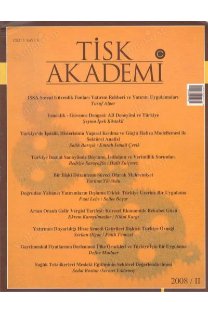Motivasyon Teorileri ve Kamu Çalışanlarının Bireysel Performans Değerlendirme Temelinde Teşvik Edilmesi
Motivation Theories and Encouraging Public Employees Based on Individual Performance Evaluation
___
- Aktan, C. C. (2005). Değişim Çağında Yönetim, İstanbul: Sistem Yayıncılık.
- Alford D. and J. OFlynn (2012).Rethinking Public Service Delivery, Managing with External Providers. England: Palgrave Macmillan Distribution.
- Andrews, R., G.A. Boyne and R. M. Walker (2006). Subjective and Objective Measures of Organizational Performance: An Amprical Exploration Public Service Performance Perspectives on Measurement and Management, Cambridge.
- Apospori, E., Papalexandiris N. and Glanaki, E., (2005). Entreprenurial and Professional CEOs, Differences in Motive and Responsibility Profile. Leadership & Organization Development Journal. Vol. 26, No. 2, 141-162.
- Archmann,S. and J. C. Iglesias (2010).e GovernmentA Driving Force for Innovation and Efficiency in Public Administration. EI-PASCOPE, Vol. 2010/1, 29-36.
- Bella, Nicola (2013). Experimental Evidence on the Relationship between Public Service Motivation and Job Performance. Public Administration Review. Vol. 73, January-February, Iss. 1, 143 153.
- Berl, R.L. and Williamson, N.C. (1987). A Review of the Content Theories of Motivation as They Apply to Sales and Sales Management, American Business Review.
- Biget, Simon Anderfuhren, Frederic, V. and Giauque D. (2014). Policy Environment and Public Service Motivation. Public Administration. Vol. 92, No. 4, 807825. John Wiley & Sons Ltd.
- Binderkrantz, Anne Skorkjær, J. G. Christensen (2011). Agency Performance and Executive Pay in Government: An Empirical Test. Journal of Public Administration Research and Theory. No. 22, 3154.
- Cho, Y. J. and Perry, J. L. (2012). Intrinsic Motivation and Employee Attitudes: Role of Managerial Trustworthiness, Goal Directedness, and Extrinsic Reward Expectancy. Review of Public Personnel Administration. No. 32, 382 406.
- Eraslan,T. ve Tozlu A. (2011). Kamu Yönetiminde Performansa Dayalı Ücret Sistemi. Sayıştay Dergisi. Sayı 81, 33-61.
- Gilette, B. (2005). Pay for Performance Measurement Helps Set the Bar for Quality, Efficient Care. Managed Heatlhcare Executive. December, 2005.
- Hisrich, D.R. and Al-Dabbagh (2013). A., Governpreneurship, Establishing a Thriving Entrepreneurial Spirit in Government. Massachusetts: Edgar Elgar Publishing Limited.
- Holzer, M. and R.W. Shwester (2011).Public Administration: An Introduction. New Delhi: PHI Learning.
- Jreisat, J. (2012). Globalism and Comparative Public Administration. NW: Taylor and Francis Group CRC Press.
- Johns, G. and Saks, A.M., (2001). Organizational Behaviour. 5th Edition. USA: Pearson Education Canada Inc., Toronto.
- Karwan, K. R. and Markland, R. E. (2006). Integrating service design principles and information technology to improve delivery and productivity in public sector operations: The case of the South Carolina DMV. Journal of Operations Management. No: 24, 347 - 362.
- Koçel, T. (2005). İsletme Yöneticiliği. 10. Baskı. İstanbul: Arıkan Yayıncılık.
- Kotler, Philip and L. Nancy (2007). Marketing in the Public Sector, A Roadmap for Improved Performance. New Jersey.
- Lau, M. C. and Roopnarain, K. (2014). The effects of nonfinancial and financial Measures on Employee Motivation to Participate in Target Setting. The British Accounting Review. No. 46, 228-247.
- Li, Wei, P. Alamand N. Meonske (2013). Performance measure properties and efficacy of incentive contracts: perceptions of U. S. Employees. The International Journal of Human Resource Management. Vol. 24, No. 17, 33783392.
- Lyons, M. and Dalton, B. (2011). Avustralia: A Continuing Love Affair with the New Public Management. Governance and Regulation in the Third Sector, International Perspectives. Edit by. Susan D. Phillips and Steven Rathgreb Smith. New York: Routledge.
- Maslow, A., (1970). Motivation and Personality. Second Edition. USA: Harper & Row Publishers.
- McClelland, D.C. (1961). The Achieving Society. Princeton, NY: Van Nostrand.
- McClelland, D.C. and WINTER D.G., (1969). Motivating Economic Achievement. New York: The Free Press.
- Moorhead, G. and Griffin, R.W., (1989).Organizational Behavior, 2nd Edition. USA: Houghton Mifflin Company.
- Mullins, L.J., (2002). Management and Organizational Behaviour. UK: Prentice Hall 6th Edition.
- OECD (2008). The State of the Public Service. Paris.
- OECD (2012). Civil Service Professionalisation in Western Balkans. SIGMA Papers No.48. Paris.
- Özer, P.S. and Topaloğlu, T. (2008). Motivasyonda Kapsam Kuramları, Liderlik ve Motivasyon. Editor: Celaleddin Serinkan. Ankara: Nobel Yayın Dağıtım.
- Özgür, Bünyamin (2008). Kamuda Yönetici Performansının Bütüncül Değerlendirilmesi (Yeni Bir Model Önerisi). Maliye Dergisi, Sayı: 154, 38-51.
- Pappas, J. M. and K.E. Flahert (2006). The Moderating Role of Individual Difference Variables in Compensation Research. Journal of Managerial Psychology. Vol. 21, No.1.
- Rainey, H. G. (2006). Understanding and Managing Public Organizations, (4th edition). John Wiley & Sons Inc.
- Schuster, Jay R. and P. K. Zingheim(1993). New Pay Strategies That Work. Journal of Compensation and Benefits, No:6, May/ June.
- Taylor, J. (2014). Public Service Motivation, Relational Job Design, and Job Satisfaction in Local Government. Public Administration. Vol. 92, No. 4, 902 918.
- Tozlu, A. (2014). Kamu Kesiminde Performans Değerlendirme Sistemi: İş ve Meslek Danışmanlarına Yönelik Bir Uygulama Önerisi. Ankara: Kalkınma Bakanlığı.
- Vandenabeele, W., Brewer, G.A. and Ritz, A.(2014). Past, Present, and Future of Public Service Motivation Research. Public Administration. Vol. 92, No. 4, 779 789.
- Web-based Resources
- http://www.oecd.org
- http://www.ppmrn.net (Rutgers, School of Public Affairs and Administration, Public Performance Measurement & Reporting Network, accessed to information in 04.01.2015) .
- ISSN: 1306-6757
- Yayın Aralığı: 2
- Başlangıç: 2006
- Yayıncı: Türkiye Isveren Sendikalari Konfederasyonu
MERTER AKINCI, GÖNÜL YÜCE AKINCI, ÖMER YILMAZ
Hiyerarşik Düzenden Heterarşik Düzene: Yönetişim Kavramı ve Yönetişim Teorileri
EBRU CANIKALP, İLTER ÜNLÜKAPLAN
Türk Bankacılık Sektörünün Küresel Kriz Öncesi ve Sonrasında Mülkiyet Ayrımında İncelenmesi
Ceza İnfaz Kurumları Dışında Çalıştırılan Hükümlülerin Sosyal Güvenliği
Türkiye'de 6360 ve 6447 Sayılı Kanunlarla Kurulan Büyük Şehirlerin Göreli Kalkınma Düzeyleri
İnsan Kaynakları Yönetimi Uygulamalarının Örgütsel Vatandaşlık Davranışı Üzerindeki Etkileri
MUSTAFA FEDAİ ÇAVUŞ, ALPTEKİN DEVELİ
Ev Hizmetlerinde Çalışanların Sosyal Güvenliği
Günlük Hayatta ve Second Life Adlı İnternet Platformunda Kendilik Sunumunun Kısa Bir İncelemesi
